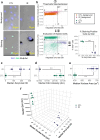A Fully-Automated Senescence Test (FAST) for the high-throughput quantification of senescence-associated markers
- PMID: 38869711
- PMCID: PMC11336018
- DOI: 10.1007/s11357-024-01167-3
A Fully-Automated Senescence Test (FAST) for the high-throughput quantification of senescence-associated markers
Abstract
Cellular senescence is a major driver of aging and age-related diseases. Quantification of senescent cells remains challenging due to the lack of senescence-specific markers and generalist, unbiased methodology. Here, we describe the Fully-Automated Senescence Test (FAST), an image-based method for the high-throughput, single-cell assessment of senescence in cultured cells. FAST quantifies three of the most widely adopted senescence-associated markers for each cell imaged: senescence-associated β-galactosidase activity (SA-β-Gal) using X-Gal, proliferation arrest via lack of 5-ethynyl-2'-deoxyuridine (EdU) incorporation, and enlarged morphology via increased nuclear area. The presented workflow entails microplate image acquisition, image processing, data analysis, and graphing. Standardization was achieved by (i) quantifying colorimetric SA-β-Gal via optical density; (ii) implementing staining background controls; and (iii) automating image acquisition, image processing, and data analysis. In addition to the automated threshold-based scoring, a multivariate machine learning approach is provided. We show that FAST accurately quantifies senescence burden and is agnostic to cell type and microscope setup. Moreover, it effectively mitigates false-positive senescence marker staining, a common issue arising from culturing conditions. Using FAST, we compared X-Gal with fluorescent C12FDG live-cell SA-β-Gal staining on the single-cell level. We observed only a modest correlation between the two, indicating that those stains are not trivially interchangeable. Finally, we provide proof of concept that our method is suitable for screening compounds that modify senescence burden. This method will be broadly useful to the aging field by enabling rapid, unbiased, and user-friendly quantification of senescence burden in culture, as well as facilitating large-scale experiments that were previously impractical.
Keywords: Aging; Cellular senescence; High-content image analysis; High-throughput screening; Machine learning; Senescence-associated-β-galactosidase.
© 2024. The Author(s).
Conflict of interest statement
J.C. was a founder and shareholder of Unity Biotechnology that develops senolytic drugs. A.A.G. has financial interest in Image Analyst Software. All other authors declare no conflict of interest.
Figures







Update of
-
A Fully-Automated Senescence Test (FAST) for the high-throughput quantification of senescence-associated markers.bioRxiv [Preprint]. 2024 Mar 12:2023.12.22.573123. doi: 10.1101/2023.12.22.573123. bioRxiv. 2024. Update in: Geroscience. 2024 Oct;46(5):4185-4202. doi: 10.1007/s11357-024-01167-3. PMID: 38187756 Free PMC article. Updated. Preprint.
Similar articles
-
A Fully-Automated Senescence Test (FAST) for the high-throughput quantification of senescence-associated markers.bioRxiv [Preprint]. 2024 Mar 12:2023.12.22.573123. doi: 10.1101/2023.12.22.573123. bioRxiv. 2024. Update in: Geroscience. 2024 Oct;46(5):4185-4202. doi: 10.1007/s11357-024-01167-3. PMID: 38187756 Free PMC article. Updated. Preprint.
-
Genotoxic Stress-Induced Senescence.Methods Mol Biol. 2019;1896:93-105. doi: 10.1007/978-1-4939-8931-7_10. Methods Mol Biol. 2019. PMID: 30474843
-
SA-β-Galactosidase-Based Screening Assay for the Identification of Senotherapeutic Drugs.J Vis Exp. 2019 Jun 28;(148). doi: 10.3791/58133. J Vis Exp. 2019. PMID: 31305507
-
Methods to detect biomarkers of cellular senescence: the senescence-associated beta-galactosidase assay.Methods Mol Biol. 2007;371:21-31. doi: 10.1007/978-1-59745-361-5_3. Methods Mol Biol. 2007. PMID: 17634571 Review.
-
Aging of the cells: Insight into cellular senescence and detection Methods.Eur J Cell Biol. 2020 Aug;99(6):151108. doi: 10.1016/j.ejcb.2020.151108. Epub 2020 Jul 12. Eur J Cell Biol. 2020. PMID: 32800277 Review.
Cited by
-
A nutrigeroscience approach: Dietary macronutrients and cellular senescence.Cell Metab. 2024 Sep 3;36(9):1914-1944. doi: 10.1016/j.cmet.2024.07.025. Epub 2024 Aug 22. Cell Metab. 2024. PMID: 39178854 Free PMC article. Review.
-
Influence of a Zombie-like State of the Liver on Drugs and Its Medico-Legal Implications: A Scoping Review.Pharmaceuticals (Basel). 2025 May 24;18(6):787. doi: 10.3390/ph18060787. Pharmaceuticals (Basel). 2025. PMID: 40573181 Free PMC article. Review.
-
Senolytic compounds reduce epigenetic age of blood samples in vitro.NPJ Aging. 2025 Feb 4;11(1):6. doi: 10.1038/s41514-025-00199-z. NPJ Aging. 2025. PMID: 39905063 Free PMC article.
-
The DNA Damage Response as an Auxiliary Indicator of Senescence in Cancer: A User-Friendly Toolkit of Markers and Detection Methods.Methods Mol Biol. 2025;2906:83-112. doi: 10.1007/978-1-0716-4426-3_6. Methods Mol Biol. 2025. PMID: 40082352
-
A comprehensive update on the application of high-throughput fluorescence imaging for novel drug discovery.Expert Opin Drug Discov. 2025 Jun;20(6):785-797. doi: 10.1080/17460441.2025.2499123. Epub 2025 May 5. Expert Opin Drug Discov. 2025. PMID: 40305163 Review.
References
MeSH terms
Substances
Grants and funding
LinkOut - more resources
Full Text Sources

